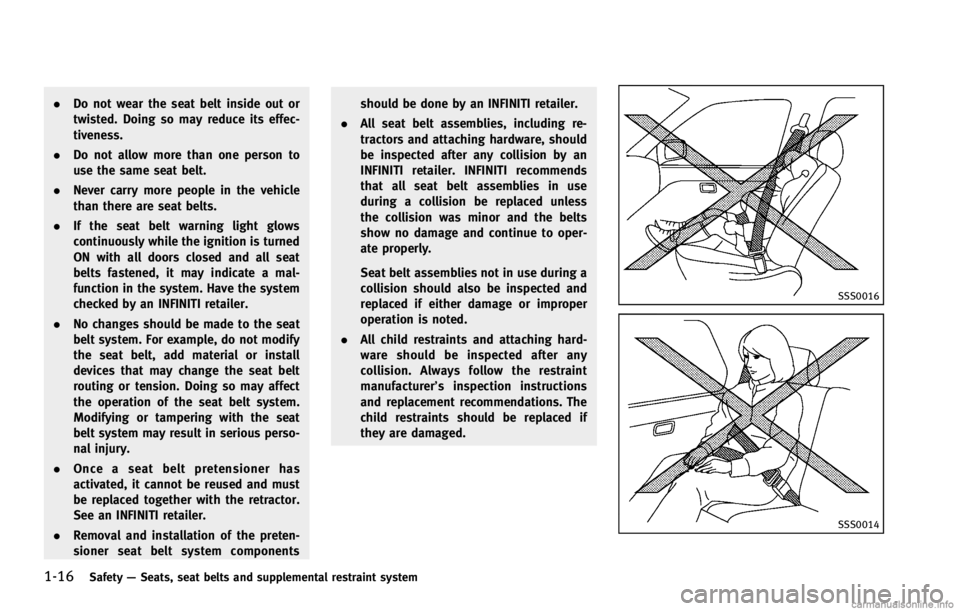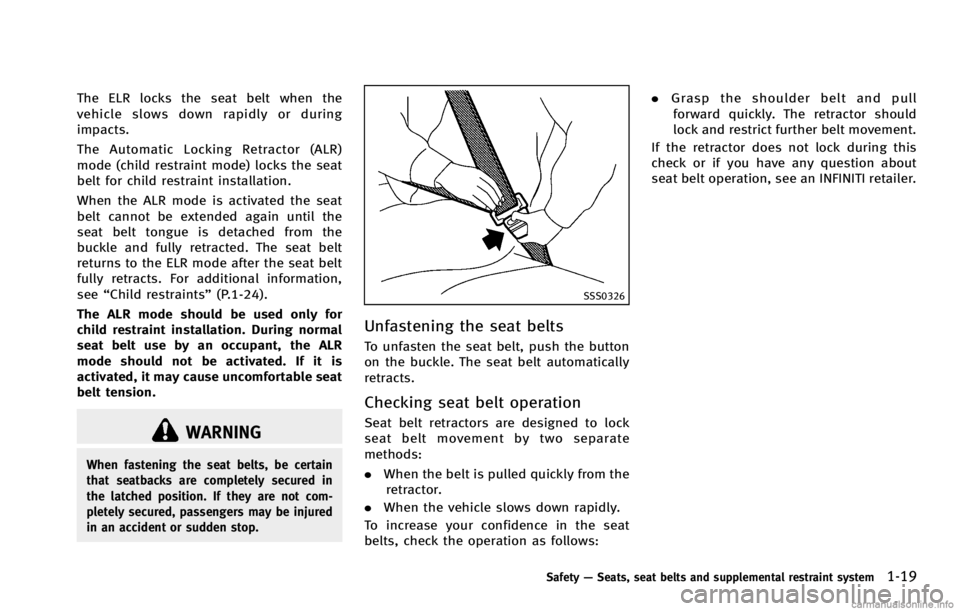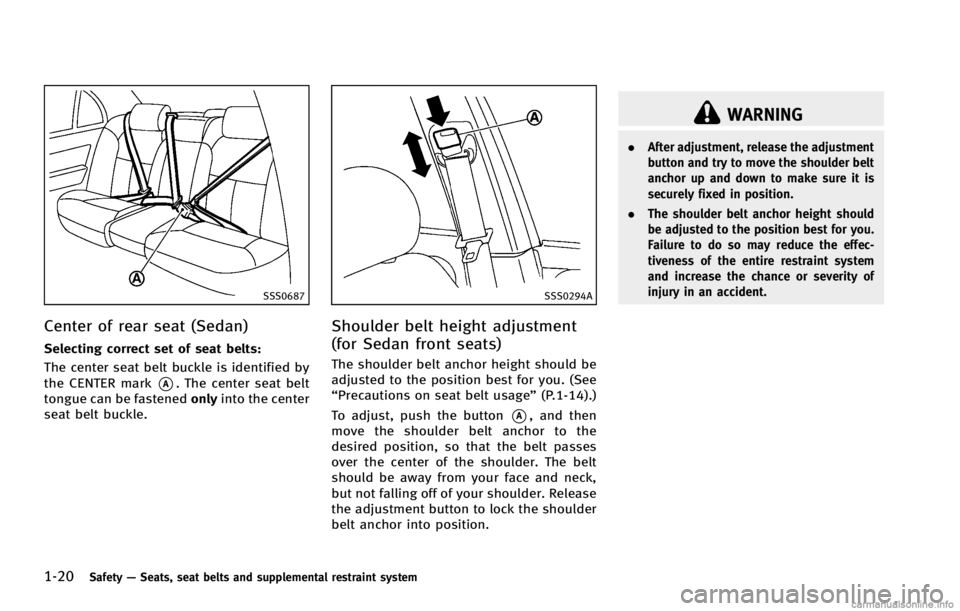INFINITI G COUPE 2013 User Guide
G COUPE 2013
INFINITI
INFINITI
https://www.carmanualsonline.info/img/42/34945/w960_34945-0.png
INFINITI G COUPE 2013 User Guide
Page 32 of 490
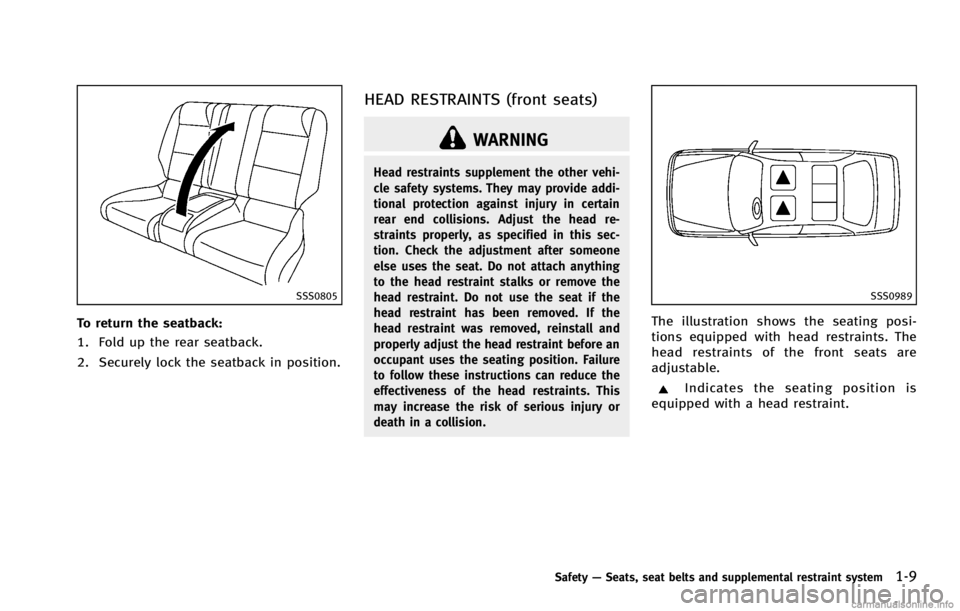
SSS0805
To return the seatback:GUID-D73A39BF-43C8-459F-9C24-47B7F579C407
WARNING
Head restraints supplement the other vehi-
cle safety systems. They may provide addi-
tional protection against injury in certain
rear end collisions. Adjust the head re-
straints properly, as specified in this sec-
tion. Check the adjustment after someone
else uses the seat. Do not attach anything
to the head restraint stalks or remove the
head restraint. Do not use the seat if the
head restraint has been removed. If the
head restraint was removed, reinstall and
properly adjust the head restraint before an
occupant uses the seating position. Failure
to follow these instructions can reduce the
effectiveness of the head restraints. This
may increase the risk of serious injury or
death in a collision.
SSS0989
The illustration shows the seating posi-
tions equipped with head restraints. The
head restraints of the front seats are
adjustable.
Indicates the seating position is
equipped with a head restraint.
Safety —Seats, seat belts and supplemental restraint system1-9
Page 33 of 490
1-10Safety—Seats, seat belts and supplemental restraint system
SSS0992
ComponentsGUID-DBDCC61D-24FD-4E47-A348-FDC0C6CDF960
SSS0997
AdjustmentGUID-8B4E4C06-4D63-4200-A51B-5ED68936E652
SSS0993
To raise the head restraint, pull it up.
Page 35 of 490
1-12Safety—Seats, seat belts and supplemental restraint system
SSS0996
InstallGUID-A0266381-3929-4791-B5F4-7F6C9A04687C
SSS0508
Front-seat Active Head RestraintsGUID-5D9BA25C-DA31-49D7-B3FB-9413B1B21746
Page 37 of 490
1-14Safety—Seats, seat belts and supplemental restraint system
key cylinder before opening or closing the
lid. Otherwise the lid and the rear armrest
may be damaged.
GUID-B5C09302-142B-4089-942C-50C42BEC0669
Page 38 of 490
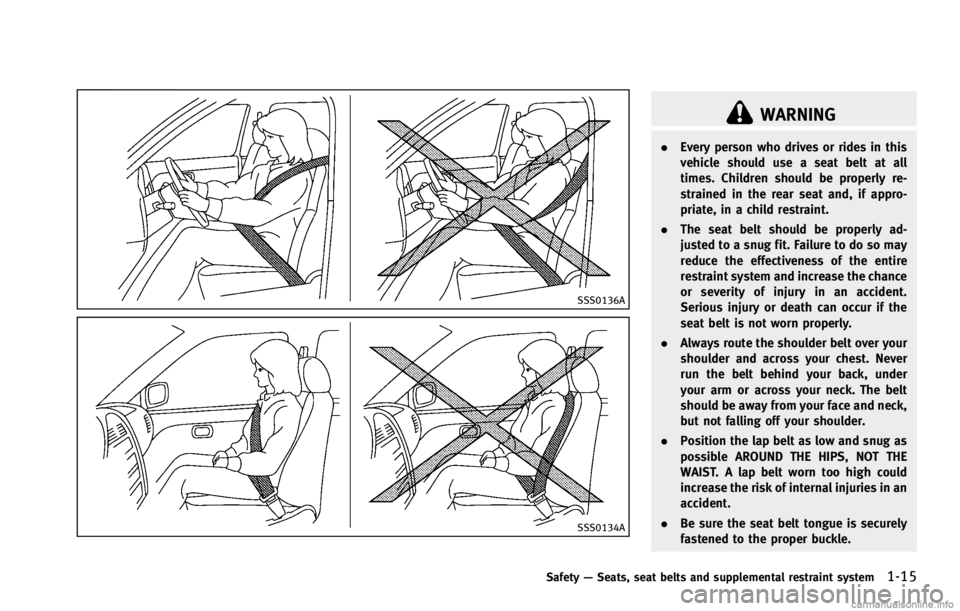
SSS0136A
SSS0134A
WARNING
.Every person who drives or rides in this
vehicle should use a seat belt at all
times. Children should be properly re-
strained in the rear seat and, if appro-
priate, in a child restraint.
. The seat belt should be properly ad-
justed to a snug fit. Failure to do so may
reduce the effectiveness of the entire
restraint system and increase the chance
or severity of injury in an accident.
Serious injury or death can occur if the
seat belt is not worn properly.
. Always route the shoulder belt over your
shoulder and across your chest. Never
run the belt behind your back, under
your arm or across your neck. The belt
should be away from your face and neck,
but not falling off your shoulder.
. Position the lap belt as low and snug as
possible AROUND THE HIPS, NOT THE
WAIST. A lap belt worn too high could
increase the risk of internal injuries in an
accident.
. Be sure the seat belt tongue is securely
fastened to the proper buckle.
Safety —Seats, seat belts and supplemental restraint system1-15
Page 39 of 490
1-16Safety—Seats, seat belts and supplemental restraint system
SSS0016
SSS0014
Page 40 of 490
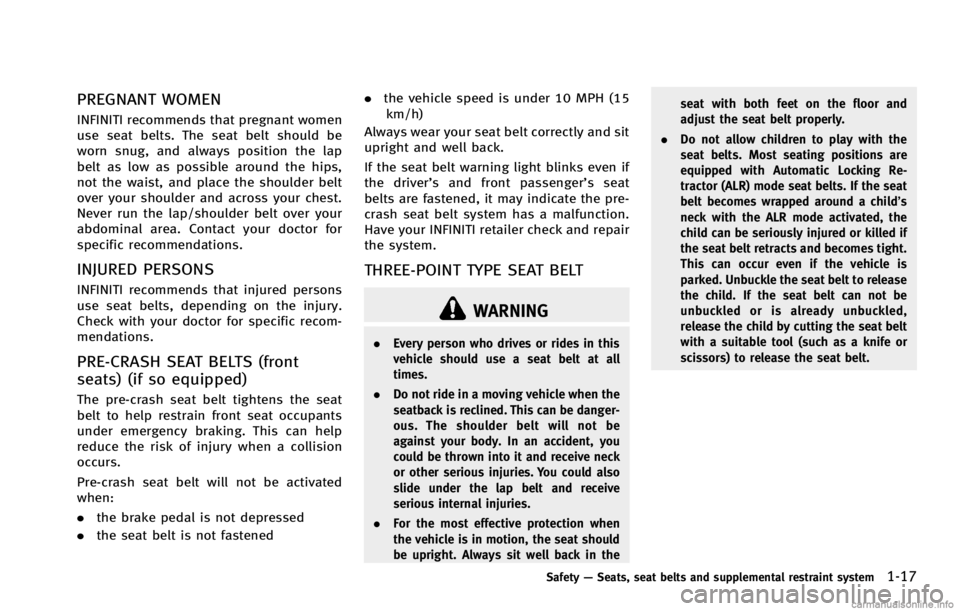
WARNING
.Every person who drives or rides in this
vehicle should use a seat belt at all
times.
. Do not ride in a moving vehicle when the
seatback is reclined. This can be danger-
ous. The shoulder belt will not be
against your body. In an accident, you
could be thrown into it and receive neck
or other serious injuries. You could also
slide under the lap belt and receive
serious internal injuries.
. For the most effective protection when
the vehicle is in motion, the seat should
be upright. Always sit well back in the seat with both feet on the floor and
adjust the seat belt properly.
. Do not allow children to play with the
seat belts. Most seating positions are
equipped with Automatic Locking Re-
tractor (ALR) mode seat belts. If the seat
belt becomes wrapped around a child’s
neck with the ALR mode activated, the
child can be seriously injured or killed if
the seat belt retracts and becomes tight.
This can occur even if the vehicle is
parked. Unbuckle the seat belt to release
the child. If the seat belt can not be
unbuckled or is already unbuckled,
release the child by cutting the seat belt
with a suitable tool (such as a knife or
scissors) to release the seat belt.
Safety —Seats, seat belts and supplemental restraint system1-17
Page 41 of 490
1-18Safety—Seats, seat belts and supplemental restraint system
SSS0292
Fastening the seat beltsGUID-B37DD1F9-9FF6-46C4-80B5-F68C6BFB1F41
SSS0290
3. Position the lap belt portion low and
snug on the hips as shown.
4. Pull the shoulder belt portion toward the retractor to take up extra slack. Be
sure the shoulder belt is routed over
your shoulder and across your chest.
The three-point type seat belts have two
modes of operation:
. Emergency Locking Retractor (ELR)
. Automatic Locking Retractor (ALR)
The Emergency Locking Retractor (ELR)
mode allows the seat belt to extend and
retract to allow the driver and passengers
some freedom of movement in the seat.
Page 42 of 490
WARNING
When fastening the seat belts, be certain
that seatbacks are completely secured in
the latched position. If they are not com-
pletely secured, passengers may be injured
in an accident or sudden stop.
SSS0326
Unfastening the seat beltsGUID-E5ABF433-63F1-41B4-9060-772462985B76
Page 43 of 490
1-20Safety—Seats, seat belts and supplemental restraint system
SSS0687
Center of rear seat (Sedan)GUID-F8C852B7-8F2B-4F66-B9F1-740AF287A7F1
SSS0294A
Shoulder belt height adjustment
(for Sedan front seats)
GUID-9DA0069A-F53D-4536-89F5-3F6983A3F7DF
WARNING
. After adjustment, release the adjustment
button and try to move the shoulder belt
anchor up and down to make sure it is
securely fixed in position.
. The shoulder belt anchor height should
be adjusted to the position best for you.
Failure to do so may reduce the effec-
tiveness of the entire restraint system
and increase the chance or severity of
injury in an accident.





